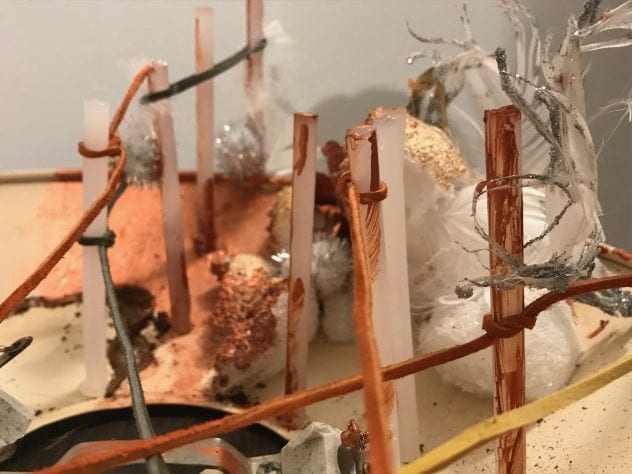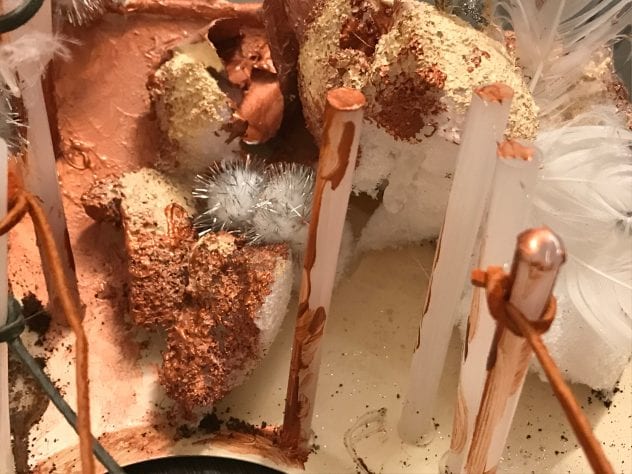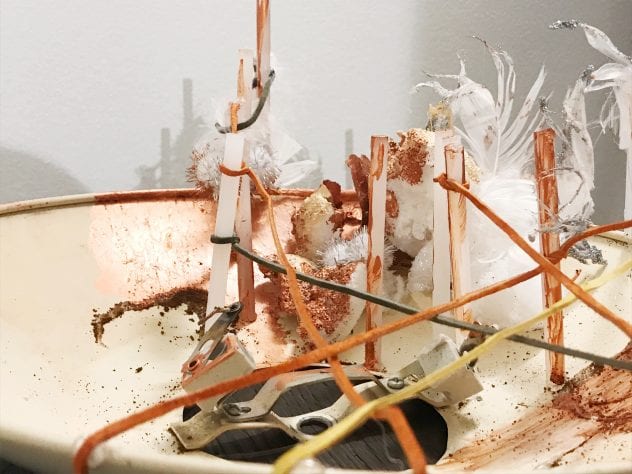For Bridge 3, I created “Failed Bourgeois Playground.” The piece is a visual representation of six sources I looked to help me better understand the following research question I have in mind: What is the effect of the gentrification in East Williamsburg for small authentic businesses?
To make it I was inspired by Joseph Cornell’s Cabinets of Curiosity. His boxes leave space for reflection, curiosity, and interpretation. He represented in his boxes what unfolded from his inspiration from Juan Gris’ work. In “Failed Bourgeois Playground,” I represented what I found interesting from my sources by including an element of each in the piece. (The sources are included at the end of the post as part of the bibliography section)
The following image is an example of a Joseph Cornell’s box that I found particularly interesting: 
Untitled (Celestial Navigation), 1958. (http://alexkittle.com/2014/10/16/art-joseph-cornells-assemblages/)
After having the opportunity to get to understand more Cornell’s work, I began to think about my own. First I chose which of my primary sources I was going to use. Then I found my secondary sources, which were inspired by the information I found in my primary sources.
The process from learning what I thought was interesting of my sources to creating a concept for it is illustrated below:
With the idea of how I wanted to display every source, I decided to take a walk and find a base and materials to make it. In my walk, I found a lamp in the trash that caught my attention. I thought the top of the lamp could be a good base for my piece. The top of the lamp represented the “character” and “authenticity” that I believe is essential for neighborhoods that are being gentrified (such as East Williamsburg) to maintain. 
I also went to Michaels to get some art supplies. I bought white feathers with silver glitter to make the “bourgeois playground” part of the piece, and I bought glue sticks to make the frontier between that and the “authentic” businesses. For the rest of the piece I used materials I already owned such as suede strings, paper, paint, and coffee.
I took out the cables and the bottom part of the lamp. I also cleaned it.

Afterwards, I began making the “bourgeois playground”, the barriers, and the holes at the bottom of the sculpture. 
Consequently, I painted the playground, and added feathers to make it seem luxurious.
My final step was to include the connections made out of string:
Photos of the final piece:
The first primary source argues that in Brooklyn the areas that are being gentrified are becoming “bourgeois playgrounds.” I included a visual representation of this with an environment of imaginary luxurious rocks. My second source were statistics from the NYC Department of Planning on the percentage of structures constructed since 1990 in East Williamsburg, which was of around 20%. To represent this, I included small spheres with silver decorations as part of the imaginary luxurious environment. I also interpreted my secondary sources and included their visualizations. The first secondary source stated that food was becoming less accessible to the longstanding residents. I responded to this by adding black and brown spots in the sculpture. The second source’s main point was that houses near satisfying supermarkets such as Whole Foods were most expensive than others that did not. With gentrification, living in East Williamsburg will become more and more costly to live with the years. I represented that in the piece by creating a barrier made with hot glue that separates both worlds (the bourgeois playground and the old businesses of the area). The third secondary source argued that a city needs old restaurants that will create the character of the space. My visualization of this is shown with the choice of a recycled base for the piece. The final source was about a restaurant owner in Brooklyn that is aware that she might have to adapt to the changes that gentrification is bringing to her business to make sure she continues in the market. To show this is used suede strings to connect the “bourgeois playground” and the “authentic/old” world to state that there has to be an agreement by both parties to grow healthily and stably.
Bibliographies
Primary Sources
New York City Department of Planning. “Housing Profile 2012-2016 American Community Survey.” NYC Population FactFinder, popfactfinder.planning.nyc.gov/profile/994/housing
Ortega, Amanda. “Hofstra Papers in Anthropology.” Living/Learning Communities | Hofstra | New York. Accessed July 26, 2018. https://www.hofstra.edu/academics/colleges/hclas/anthro/hpia/hpia-ortega.html
Secondary Sources
Anderson, Jamie. “Whole Foods & Trader Joe’s Provide a Healthy Boost to Nearby Homes – Zillow Research.” Premier Agent Resource Center. October 11, 2017. Accessed July 26, 2018. https://www.zillow.com/research/whole-foods-trader-joes-home-value-11696/.
Boo, James. “A Brooklyn Chef Comes to Terms with Her Gentrifying Neighborhood.” Edible Brooklyn. September 25, 2017. Accessed July 26, 2018. https://www.ediblebrooklyn.com/2017/bk-maite/
Cohen, Nevin. “Feeding or Starving Gentrification: The Role of Food Policy.” CUNY Urban Food Policy Institute, 27 Mar. 2018, www.cunyurbanfoodpolicy.org/news/2018/3/27/feeding-or-starving-gentrification-the-role-of-food-policy
Viverito, Melissa Mark. “Feeding or Starving Gentrification: The Role of Food Policy.” CUNY Urban Food Policy Institute. December 2017. Accessed July 26, 2018. http://www.cunyurbanfoodpolicy.org/news/2018/3/27/feeding-or-starving-gentrification-the-role-of-food-policy.







